Figures & data
Table 1. The physical and chemical characteristics of experimental soil surface (0–30 cm) evaluated during the 2022/2023 and 2023/2024 seasons.
Table 2. Effect of ZnO-NPs, proline and their combination on plant height (cm), dry weight (g)/plant and leaf area (cm2)/plant of pea plants irrigated with diluted seawater levels (2.5 and 5%) after 50 days from sowing during 2022/2023 and 2023/2024 seasons.
Figure 1. Effect of ZnO-NPs, proline and their combination on chlorophyll content (chl. a, b and total chl.) of pea plants irrigated with diluted seawater levels (DSW) after 50 days from sowing during 2022/2023 and 2023/2024 seasons. Values sharing at least one identical letter were not significantly various at the P < 0.05 level.
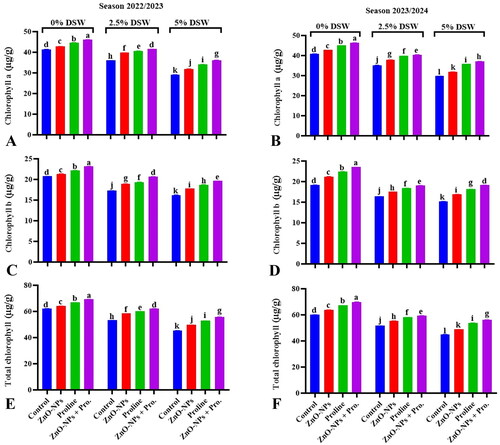
Figure 2. Effect of ZnO-NPs, Proline and their combination on antioxidants enzymes (CAT, POD, and PPO) activity of pea plants irrigated with diluted seawater after 50 days from sowing during 2022/2023 and 2023/2024 seasons. Values sharing at least one identical letter were not significantly various at the P < 0.05 level.
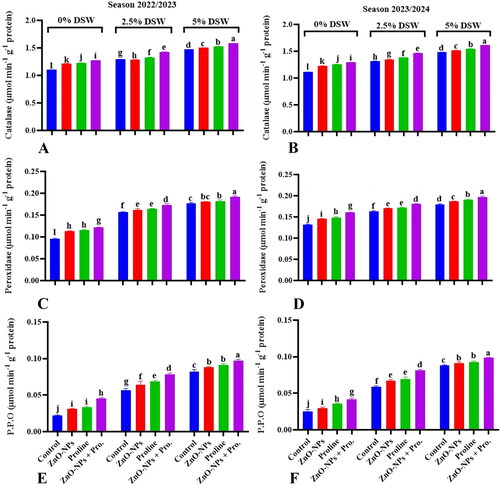
Figure 3. Effect of ZnO-NPs, proline and their combination on endogenous proline (A,B), leaf membrane stability index (C,D) or phenols content (E,F) of pea plants irrigated with seawater diluted after 50 days from sowing during 2022/2023 and 2023/2024 seasons. Values sharing at least one identical letter were not significantly various at the P < 0.05 level.
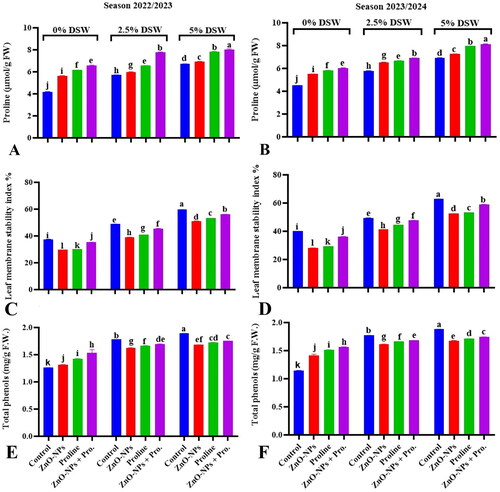
Figure 4. Effect of ZnO-NPs, proline and their combination on leaf CO2 (A), leaf H2O2 content (B), stomatal conductance (C), transpiration rate (D) and net photosynthesis (E) leaf membrane stability index (C,D) or phenols content (E and F) of pea plants irrigated with seawater diluted after 50 days from sowing during 2023/2024 season. Values sharing at least one identical letter were not significantly various at the P < 0.05 level.
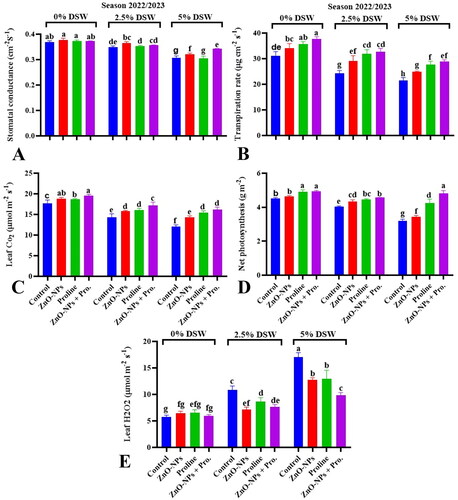
Figure 5. Effect of ZnO-NPs, proline and their combination on number of pods/plant (A,B), green pods weight/plant (C,D) and an average of seed dry weight (E,F), of pea plants irrigated with seawater diluted after 70 days from sowing during 2023/2024 season. Values sharing at least one identical letter were not significantly various at the P < 0.05 level.
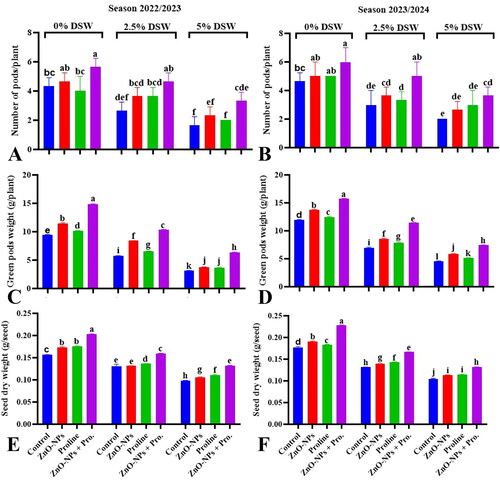
Figure 6. Effect of proline and zinc nanoparticles (ZnO-NPs) and their combination on total carbohydrates% (A,B), vitamin C (C,D) or crude protein percentage (E,F) contents in seeds of pea plants irrigated with seawater diluted after 70 days from sowing during 2022/2023 and 2023/2024 seasons. Values sharing at least one identical letter were not significantly various at the P < 0.05 level.
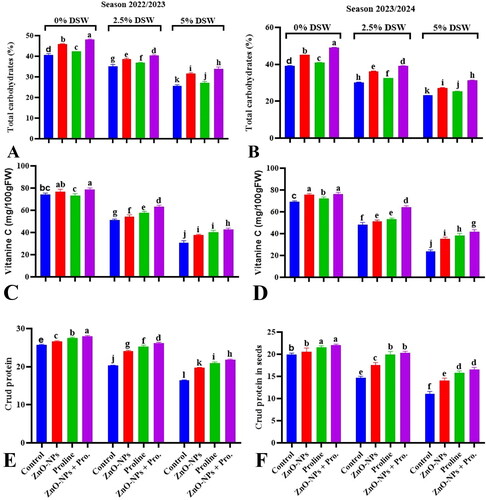
Figure 7. Effect of proline and zinc nanoparticles (ZnO-NPs) and their combination on percentage of nitrogen (A,B), potassium (C,B), and phosphorus (E,F) percentage in seeds of pea plants irrigated with diluted seawater after 70 days from sowing during 2022/2023 and 2023/2024 seasons. Values sharing at least one identical letter were not significantly various at the P < 0.05 level.
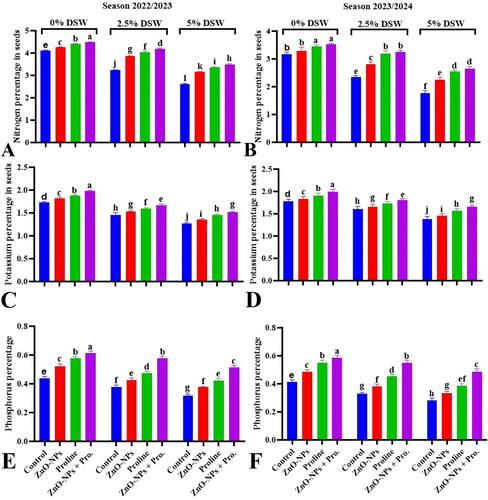
Figure 8. A graphical abstract outlining the adverse effects of irrigating pea plants with diluted seawater (salinity stress) and the mitigation of these negative impacts through the application of proline and zinc oxide nanoparticles (ZnO-NPs), whether applied individually or in combination via foliar spray.
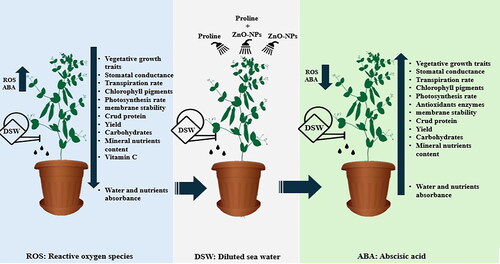
Figure 9. Heatmap analysis of the growth, physiological or biochemical attributes in pea plants unstressed and stressed (irrigated with diluted seawater: DSW 2.5% and DSW 5%) treated with ZnO-NPs, proline and their interaction, chlorophyll a (Ch a), chlorophyll b (Ch b), total chlorophyll (Total Ch), catalase (CAT), peroxidase (POD), polyphenoloxidase (PPO), potassium percentage (K%), phosphorus percentage (P%) and nitrogen percentage (N%).
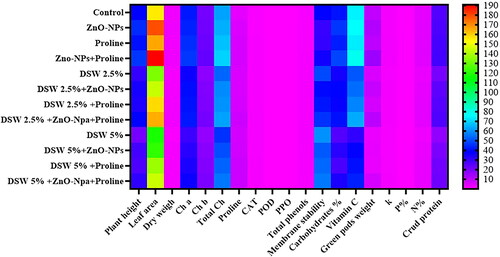
Data availability statement
The authors confirm that the data supporting the findings of this study are available within the article.

